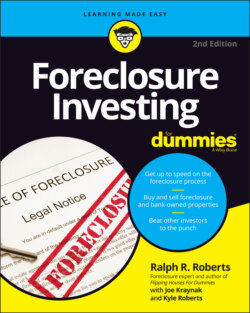Читать книгу Foreclosure Investing For Dummies - Ralph R. Roberts - Страница 11
Investigating the Foreclosure Process from Start to Finish
ОглавлениеA common misconception of foreclosure is that after the homeowners miss a payment or two, the lender immediately takes possession of the property, and then turns around and auctions it off at a foreclosure sale. But the process is more drawn out than that, and it follows this typical scenario:
1 The homeowners stop making mortgage payments.
2 After about 15 to 30 days, the lender sends a payment reminder.
3 If the homeowners don’t respond, the lender continues to send notices and may start to call the homeowners.
4 If the homeowners still don’t contact the lender, the lender turns the matter over to its collection department, which specializes in hassling homeowners.
5 After about three missed monthly payments, the lender transfers the matter to outside counsel, which is normally handled regionally. The attorney sends an official notice, warning that foreclosure proceedings are about to begin.
6 The homeowners don’t reply or present a solution that the lender deems to be unsatisfactory. At this point, the homeowners can usually stop the foreclosure by negotiating a suitable solution with the lender.
7 The attorney begins the foreclosure process by posting a foreclosure notice in the county’s legal newspaper or in the local newspaper. The homeowners can still reinstate the mortgage at this point by catching up on the payments and paying any additional late fees and penalties, which occurs quite often. See Chapter 8 for details on how to track foreclosure notices. (The county legal newspaper serves the public and provides the legal community an automated system, but it’s not free.)
8 Foreclosure paperwork for the property arrives at the civil division of the sheriff’s office, which is assigned the task of handling the sale. The trustee or attorney handling the foreclosure sets the opening bid and typically advertises it in the foreclosure notice. The opening bid is the balance of the mortgage plus penalties, unpaid interest, attorney fees, and other costs that the lender has incurred during the process.
9 The sheriff or a deputy may visit the house before the sale to post a foreclosure notice and inspect the property, because redemption rights sometimes change if the homeowners abandon the property. (Some states have a redemption period after the sale, during which time the homeowners can buy back the property by paying the full amount of the loan along with taxes, interest, and penalties. This period can last up to a year.)
10 The day before the auction, the lender may adjust the opening bid up or down but may not artificially inflate it. Frequently, lenders reduce the opening bid to make the property more appealing to investors and to rid themselves of it.
11 The property goes on the auction block for sale to the highest bidder or is turned over to a trustee to liquidate the property and pay the lender.
12 An investor purchases the property at auction or from the trustee or the lender buys the property. If nobody bids higher than the opening bid which the foreclosing lender submits, control is handed over to the lender, who can take possession of the property following any redemption period, as explained next.
13 In some states, the high bidder (or lender, if nobody bids more than the opening bid) takes immediate possession of the property. In states with a redemption period, the new “owner” must wait until the expiration of the redemption period and a final court hearing with the homeowners before they can do anything with the property. If the lender takes possession of the property, the lender transfers the property to its Real Estate Owned (REO) department which prepares it for sale.
14 The previous owners move out or are evicted, and the new owner takes possession of the property.
The foreclosure process is a lose–lose situation for both the homeowners and the lender. The homeowners lose the property, and the lender takes a loss on the loan and often pays additional costs to resell the property to recoup a portion of its loss.
If you or a loved one is ever facing a foreclosure, contact the lender immediately to explore your options. Seek help sooner rather than later. Shame, anger, and denial may discourage you from seeking help, but the longer you wait, the fewer your options will be. Educate yourself, and communicate with your lender. Homeowners who panic become very vulnerable to foreclosure rescue schemes designed to strip them of any equity built up in the home. (Equity is the profit the owners would realize if they were to sell the property and pay off the mortgage.) Do your research, know your options, and don’t deal with someone who’s claiming to be your friend. A good place to start is the USA.gov Foreclosure page at www.usa.gov/foreclosure.
For more in-depth coverage of the foreclosure process, including variations in different areas of the country, see Chapter 2. For details about the foreclosure rules and regulations in your state, check out the appendix. If you’re investing in foreclosures outside the United States, search online for a reliable government website that contains details about the foreclosure process in your area.
